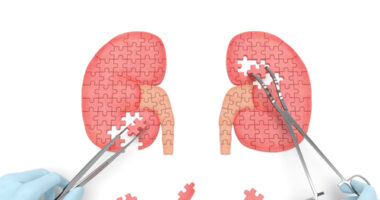Hyping Kidney Enzyme Pathway Reduces Kidney Damage in Alport Mouse Model, Study Shows

Boosting a kidney enzyme pathway reduced inflammation and kidney damage in a mouse model of Alport syndrome, suggesting that stimulating the pathway may be a treatment option, according to a study.
The pathway counterbalances another enzyme cascade that ACE inhibitors block. The inhibitors are often used to treat Alport.
The study, “Murine recombinant angiotensin-converting enzyme 2 attenuates kidney injury in experimental Alport syndrome,” was published in the journal Kidney International.
Researchers have known for some time that a kidney enzyme system, called the renin-angiotensin system, is involved in the progression of the kidney disease seen in Alport.
Drugs blocking an enzyme called ACE — for angiotensin converting enzyme — reduce inflammation and improve outcomes in animal models of the disease. And observational studies show that patients benefit from the therapy as well.
ACE transforms a compound called Angiotensin I into other factors. Another enzyme, ACE2, also can convert Angiotensin I — but into a different set of metabolites.
Researchers at the University of Toronto realized that levels of ACE2 in mice with a deleted Col4a3 gene — a known mutation in Alport — were lower than they should be.
This collection of enzymes and molecular factors can be confusing because they have similar names, so think of the system as a hot and cold water tap. When the tap handle is in the center, an equal amount of hot and cold water emerges. But if you turn the handle to either side, hot or cold water dominates.
ACE inhibitors decrease the flow through one part of the kidney enzyme pathway. Using the tap analogy, this would mean making the water less hot — a condition believed to prevent disease progression.
Researchers wanted to know if increasing ACE2 — equivalent to making the water less cold — would have similar benefits.
They treated Alport mice with a replacement ACE2 enzyme. The therapy reduced signs of fibrosis, inflammation, and oxidative stress. It also prevented kidney damage, according to observations under a microscope.
The team then treated mice which were leaking the protein albumin into their urine with a combination of the ACE2 enzyme and an ACE blocker called ramipril.
Ramipril significantly reduced the amount of albumin in the urine. When the ACE2 enzyme was added, the already reduced amount of albumin was halved, but the difference from the level achieved by the ramipril treatment was not statistically significant.
Nevertheless, researchers argued that stimulation or replacement of the ACE2 enzyme may be a valuable addition to Alport treatment.







Leave a comment
Fill in the required fields to post. Your email address will not be published.